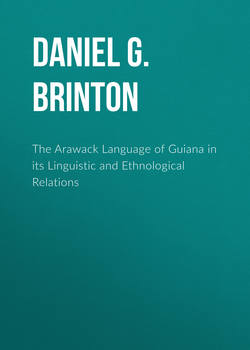Читать книгу The Arawack Language of Guiana in its Linguistic and Ethnological Relations - Daniel G. (Daniel Garrison) Brinton - Страница 4
NOUNS
ОглавлениеLike most Indians, the Arawack rarely uses a noun in the abstract. An object in his mind is always connected with some person or thing, and this connection is signified by an affix, a suffix, or some change in the original form of the word. To this rule there are some exceptions, as bahü a house, siba a stone, hiäru a woman. Dáddikân hiäru, I see a woman. Such nouns are usually roots. Those derived from verbal roots are still more rarely employed independently.
Numbers. The plural has no regular termination. Often the same form serves for both numbers, as is the case in many English words. Thus, itime fish and fishes, siba stone and stones, känsiti a lover and lovers. The most common plural endings are ati, uti, and anu, connected to the root by a euphonic letter; as uju mother, ujunuti mothers, itti father, ittinati fathers, kansissia a loved one, kansissiannu loved ones.
Of a dual there is no trace, nor does there seem to be of what is called the American plural (exclusive or inclusive of those present). But there is a peculiar plural form with a singular signification in the language, which is worthy of note. An example will illustrate it; itti is father, plural ittinati; wattinati is our father, not our fathers, as the form would seem to signify. In other words, singular nouns used with plural pronouns, or construed with several other nouns, take a plural form. Petrus Johannes mutti ujúnatu, the mother of Peter and John.
Genders. A peculiarity, which the Arawack shares with the Iroquois3 and other aboriginal languages of the Western continent, is that it only has two genders, and these not the masculine and feminine, as in French, but the masculine and neuter. Man or nothing was the motto of these barbarians. Regarded as an index of their mental and social condition, this is an ominous fact. It hints how utterly destitute they are of those high, chivalric feelings, which with us centre around woman.
The termination of the masculine is i, of the neuter u, and, as I have already observed, a permutation of the semi-vowels l and r takes place, the letter becoming l in the masculine, r in the neuter. A slight difference in many words is noticeable when pronounced by women or by men. The former would say keretin, to marry; the latter kerejun. The gender also appears by more than one of these changes: ipillin, great, strong, masculine; ipirrun, feminine and neuter.
There is no article, either definite or indefinite, and no declension of nouns.
3
Etudes Philologiques sur quelquee Langues Sauvages de l’Amerique, p. 87 (Montreal, 1866).
